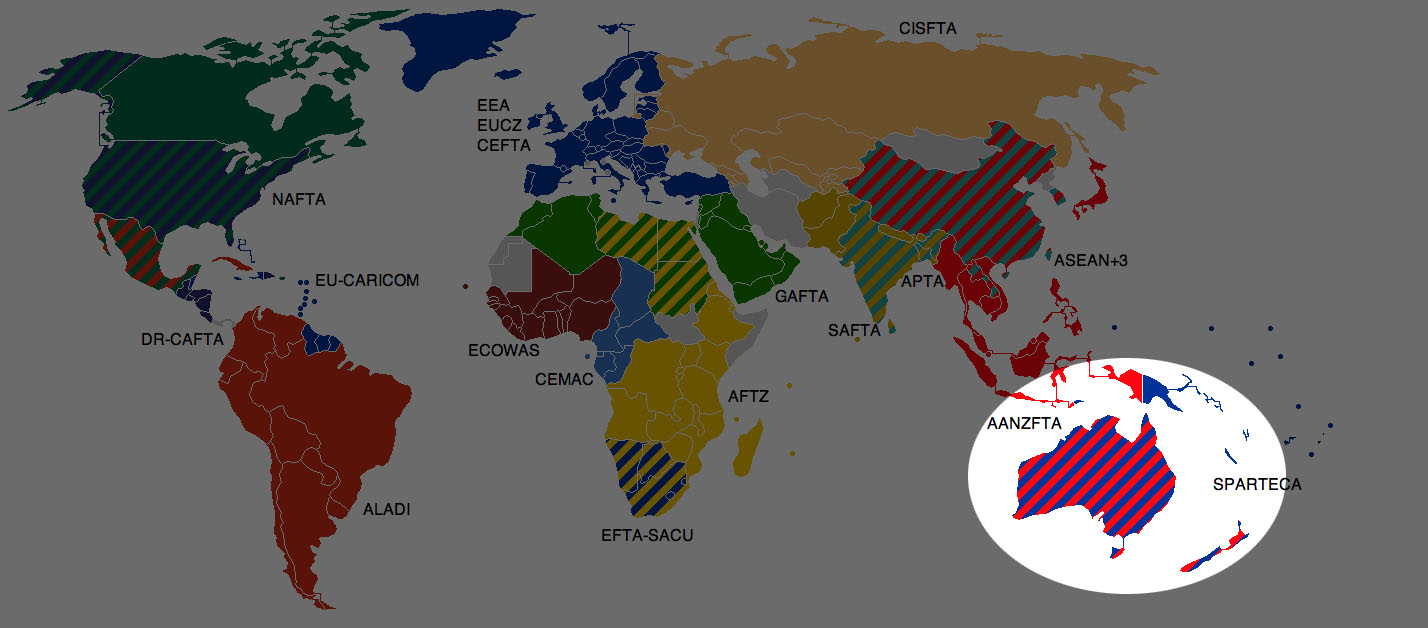For a number of island nations, the
perceived notion of isolation implies that trade with other nations
can prove challenging. In Southeast Asia, for example, resident
nations have come to rely upon each other for goods, therefore it
stands to reason that a trade agreement can benefit all involved.
Nearly fifty years ago, the Association of Southeast Asian Nations
was formed to improve the overall economic health of the region
through joint participation in trade and development. Only recently
have the ASEAN nations come together to expand relations with larger
economies, namely Australia and New Zealand.

In early 2010, the ASEAN, Australia,
New Zealand Free Trade Agreement was ratified by the following
nations:
Australia - Australia is perhaps
one of the largest countries in the southern hemisphere where mining
is a primary industry. This nation exports coal and iron ores, in
addition to livestock and beef. Their proximity to China and Japan
afford these nations status as important trade partners.
Brunei Darussalam - An oil-rich
nation, oil and natural gas rank among the country's largest
export commodities. Japan, Indonesia, and Australia benefit from
Brunei's petroleum production, which is one of the highest in the
world.
Malaysia - One of Malaysia's
top industries, computers and electronics, accounts for a good
percentage of exports to the United States. The country also trades
a variety of products with treaty partners Singapore and Thailand,
including wood and petroleum and rubber.
Myanmar - Of the AANZFTA
nations, Myanmar (Burma) has one of the smallest economies. The
country relies heavily on trade with treaty partners, including
Thailand, and exports mainly natural gas and wood products, seafood
and rice.
New Zealand - New Zealand trades
primarily with Australia, imports and exports. Largely agricultural
in terms of outgoing commodities, New Zealand exports an average of
$26 billion in dairy, meat, and fish.
The Philippines - This island
nation maintains good trade relations with several countries,
including the United States and Japan. Copper, electronics, and
textiles are among the products exported.
Singapore - Like fellow AANZFTA
members, Singapore also exports computers and accessories, and some
petroleum products. Most of their trade, with the exception of the
United States, is concentrated in Southeast Asia.
Vietnam - Vietnam is known for
textile production, especially shoes and related athletic clothing.
The country also exports some oil, wood products, and rice.
Subsequent entries into AANZFTA since
the initial establishment have included:
Cambodia - Following years of
internal conflict, Cambodia has worked in the early 21st
century to improve trade. Agricultural commodities like timber,
rubber, and seafood are popular exports, especially to the United
States.
Indonesia - Most of Indonesia's
outgoing trade is concentrated in Southeast Asia, with trade
partners receiving the country's supply of natural gas, rubber,
and textiles.
Laos - Laos produces timber
products, coffee, and textiles to major export partners, which
include AANZFTA members Thailand and Vietnam.
Thailand - While tourism is a
major income generator for Thailand, the country ranks as a top
exporter of rice. Other exports include fish and seafood, and
textiles.
Goals of the treaty, aside from
improving economies and trade across member borders, include
protection of intellectual property and eCommerce interests. As we
move deeper into the digital age, such concerns have become important
as technology comes to the region. This may prove essential in 2015,
when a proposed ASEAN Economic Community is established. This
community is designed to unify the ASEAN nations involved in this
trade agreement and create a single market and production base to
meet the growing needs of member nations. A unified economy is also
important in improving relations with outside economic powers.
With AANZFTA in force, the practice of
lower tariffs in trade among member nations should assist those
countries with smaller GDPs in obtaining needed goods and improving
internal production. Modernization of business practices and the hope
of extending relations beyond Southeast Asia may also benefit these
smaller economies and eventually reduce the isolation of this region.